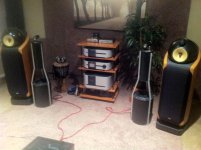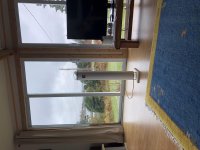Over the last almost decade I have built numerous clones and variations of the Linkwitz Pluto and LX Mini. While I appreciate the holographic imaging design approach and results I’ve never been that happy with these designs sonically. It’s something to do with the smoothness of the top end. I struggle w ssssssssy vocals and a lack of midrange clarity, punch, impact (however it can be described) - regardless of the exact configuration my attempts at using a full range driver for the top end are unsatisfying. This is especially obvious when compared side by side with other references. However I seem to be stuck on tubes and digital XO. I’d like to get this top end issue put to rest. Any ideas or shared experience out there? I spent a lot of time trying to eq this lasted design - for only a mild improvement and now a certainty that I can’t get what I’m looking for 🙂
Attachments
Last edited:
Re:
Could you give a bit more context? Crossover, Eq, measurements... You mention a U-baffle for the (I suppose) Aurasound mini driver. How did you achieve that? A picture might help...🙂
Could you give a bit more context? Crossover, Eq, measurements... You mention a U-baffle for the (I suppose) Aurasound mini driver. How did you achieve that? A picture might help...🙂
Crossover can be wherever - it's doesn't matter that much to the core quandary. The white tubes can work ok from 300 to 1000Hz or so at which point the top and bottom 5" drivers get more directional. Interestingly the imaging is still fine with up to 1000Hz at the bottom driver. U baffle is elemental; mount the Aura driver in a cross tube and allow the tube to exit the rear as well as the front. Fill the tube with various amounts of stuffing to control the low pass filtering and to damp any resonance. Still, none of that concerns my main issue which is the quality of the top end - I've been through all the combinations. Is it just me or have others had a similar experience? The Pluto and LX Mini are well regarded designs and SL was a rigorous engineer with tremendous insights and experience.
At this rate I'm going to have to abandon my DIY hobby and get some 802Ds or similar....
At this rate I'm going to have to abandon my DIY hobby and get some 802Ds or similar....
I used dayton mini-8 tweeter with the little aura 2".
O.33 uF & 0.1 mH if I remember correct...
But that had nothing to do with the SL design
O.33 uF & 0.1 mH if I remember correct...
But that had nothing to do with the SL design
How did the mini-8 work out for you? I also tried with a smaller tweeter crossed at 5K and it changed the top end a bit but the core of what I find challenging was still there - suggesting I am 'missing' something in the 1-10K range. I haven't used a flat baffle for anything to date and there's little doubt that I'm radiating more of the energy in all directions from a relative point source with my approaches.
I'd like to get this solved if possible - or at least gain an understanding of what I am observing.
Side by side the difference with the 802d is really quite clear - if also somewhat difficult to articulate.
I'd like to get this solved if possible - or at least gain an understanding of what I am observing.
Side by side the difference with the 802d is really quite clear - if also somewhat difficult to articulate.
I struggle w ssssssssy vocals and a lack of midrange clarity, punch, impact (however it can be described)
I'd recommend to make measurements if you haven't done this before.
In my case "sssss" was due to uneven frequency response in the top part of spectrum. Lack of punch was due to 1) misalignment of drivers (invalid delay and phase) and 2) incorrect level.
So, you definitely need to make measurements. Get a measurement mic. For example, umik-1. Download REW. Do some measurements.
I have a mic and I have REW and some other tools.
I have run the whole range of time alignments and spectral EQ. From exact copies of SL's notes to exploring a range of 'what happens ifs'. I also have two active sources - a mini-dsp 2x4HD with ICE power amplification and a 6 channel AB amp with computer based crossover. I can change everything on the fly with two amplification sources. Results are the same with both.
The impact on 3D imaging is quite clear and I can conclude that the designs are somewhat tolerant to various adjustments. I.e. they don't obviously stop working all of a sudden; and the characteristics that I think I have issue with seem to persist.
On the other hand, those B&W 802d units, to me at least, just sound so spectacular. Even when powered with my AB amplifier and source materials.
I'd really like to understand why.
I have run the whole range of time alignments and spectral EQ. From exact copies of SL's notes to exploring a range of 'what happens ifs'. I also have two active sources - a mini-dsp 2x4HD with ICE power amplification and a 6 channel AB amp with computer based crossover. I can change everything on the fly with two amplification sources. Results are the same with both.
The impact on 3D imaging is quite clear and I can conclude that the designs are somewhat tolerant to various adjustments. I.e. they don't obviously stop working all of a sudden; and the characteristics that I think I have issue with seem to persist.
On the other hand, those B&W 802d units, to me at least, just sound so spectacular. Even when powered with my AB amplifier and source materials.
I'd really like to understand why.
I'd recommend to make measurements if you haven't done this before.
In my case "sssss" was due to uneven frequency response in the top part of spectrum. Lack of punch was due to 1) misalignment of drivers (invalid delay and phase) and 2) incorrect level.
So, you definitely need to make measurements. Get a measurement mic. For example, umik-1. Download REW. Do some measurements.
Last edited:
I have a mic and I have REW and some other tools.
Are you able to publish your measurements?
In my experience measurements are a slippery slope of interpretation. I don't have an anechoic chamber so all results includes a bit about what's going when and where they are measured. What is it you would like to see and under what conditions?
In my experience measurements are a slippery slope of interpretation. I don't have an anechoic chamber so all results includes a bit about what's going when and where they are measured. What is it you would like to see and under what conditions?
Speaker as far from all walls as possible. Mic 5 feets to the speaker at tweeter level. Close measurements seems not to work properly with open baffle. Full range measurement from 20 to 20000 at 256K or 512K points. Decent signal against background noise.
Those 802's make a nice reference... measure both the 802s and the Linkwitz. It helps to compare have a good reference when making measurements.
Agree - measure and use a time window to "hide the room", both frequency and distortion is relevant.
I use REW to linearize my fullrange concepts, both SEAS and Markaudio drivers. I find it essential for the perceived audio quality.
I use REW to linearize my fullrange concepts, both SEAS and Markaudio drivers. I find it essential for the perceived audio quality.
lxmini just have to be 3way set up...The white tubes can work ok from 300 to 1000Hz or so at which point the top and bottom 5" drivers get more directional. Interestingly the imaging is still fine with up to 1000Hz at the bottom driver.....
This is amazing - thank-you. The 802s aren’t available atm and my mic is in a moving box somewhere. In the meantime I grabbed another set of box speakers as a side by side reference - speakers I also compared side by side with 802d for some time years ago and which essentially ended their usability. Using this ‘reference’ I was able to observe that indeed I was way off on level/eq in the 1-3k region - ie the low end of the HF driver. With some subjective poking around my Linkwitz Inspired design I was able to mitigate much of what was lacking. This is cool - side by side I am reminded of how much better the 802d sounded than my box speakers but this time it’s with my own design 🙂 🙂
I’ll dig out the mic. I must admit that I haven’t tried to gate the room response before. This all seems promising. Thx!
I’ll dig out the mic. I must admit that I haven’t tried to gate the room response before. This all seems promising. Thx!
- Home
- Loudspeakers
- Multi-Way
- Linkwitz Inspired

